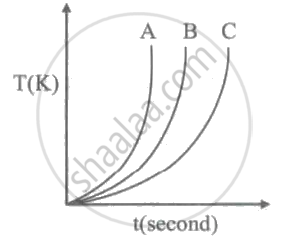Advertisements
Advertisements
प्रश्न
Two metals A and B have specific heat capacities in the ratio 2:3. If they are supplied same amount of heat then
Which metal piece will have greater mass if the rise in temperature is the same for both metals?
उत्तर
In this case, rise in temperature is same (Δ t) and masses are different.
So, for metal A,
Amount of heat (Q) = mA × 2 C × Δt;
and for metal B,
Amount of heat (Q) = mB × 3 C × Δt.
Now we can write, mA × 2C × Δt = mB × 3C × Δt.
Simplifying, mA = 1.5 mB.
Therefore, it can be said that metal A will have a greater mass than metal B.
APPEARS IN
संबंधित प्रश्न
A solid metal weighing 150 g melts at its melting point of 800 °C by providing heat at the rate of 100 W. The time taken for it to completely melt at the same temperature is 4 min. What is the specific latent heat of fusion of the metal?
Give one example where high specific heat capacity of water is used as heat reservoir ?
Give three reasons for the increase of green house gases.
State the condition for the flow of heat energy from one body to another.
Explain, why does a wise farmer water his fields, if forecast is forst?
Read the passage and answer the questions based on it.
If heat is exchanged between a hot and cold object, the temperature of the cold object goes on increasing due to gain of energy and the temperature of the hot object goes on decreasing due to loss of energy. The change in temperature continues till the temperatures of both objects attain the same value. In this process, the cold object gains heat energy and the hot object loses heat energy. If the system of both the objects is isolated from the environment by keeping it inside a heat-resistant box then no energy can flow from inside the box or come into the box. In this situation, we get the following principle.
Heat energy lost by the hot object = Heat energy gained by the cold object. This is called the ‘Principle of heat exchange’.
- Where does heat transfer take place?
- In such a situation which principle of heat do you perceive?
- How can this principle be explained in short?
- Which property of the substance is measured using this principle?
50 g of copper is heated to increase its temperature by 10° C. If the same quantity of heat is given to 5 g water, the rise in its temperature is [Specific heat of copper = 420 joule-kg-1 °C-1 , specific heat of water = 4200 joule-kg-I °C-1]
Which of the following substances (A, B and C) has the highest specific beat?

J/Kg °C is the unit of specific heat capacity.
